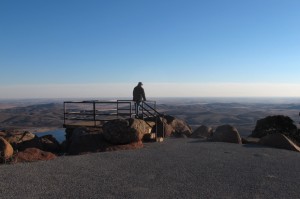EPA Rejects Texas’ Plan to Reduce Haze at Oklahoma Wildlife Refuge
-
Logan Layden

Logan Layden / StateImpact Oklahoma
Meers area resident Bill Cunningham looks for haze over the Wichita Mountains from the top of Mt. Scott.
Oklahoma’s largest utility companies will spend more than $1 billion to upgrade coal-fired power plants or retire them in favor of natural gas, all to comply with the U.S. Environmental Protection Agency’s Regional Haze Rule, which is meant to improve visibility at national parks and wildlife refuges.
But as StateImpact reported, the haze issues at the Wichita Mountains Wildlife Refuge near Lawton are being caused by power plants in Texas, not Oklahoma, and concerned residents in the area wanted to see plants in Texas held to the same standard as the ones here.
On Monday, they got their wish.
EPA announced in a press release it is rejecting parts of Texas’ plan to reduce haze and implementing its own federal rules, like it did with Oklahoma’s state-derived plan in 2013.
EPA’s proposal requires cost-effective controls, consistent with treatment used at power plants across the country, that will improve visibility in all of those areas, and prevent uncontrolled pollution emitted from Texas’ plants from drifting to Oklahoma and affecting visibility there, as required by the Clean Air Act. The federal plan would be effective until the state replaces it with an approvable state plan.
Under EPA’s proposed plan, 15 units at 8 coal-fired electricity generating facilities in Texas will be required to reduce SO2 as part of the national long-term strategy for improving visibility. These pollution controls will be very much like those already in place for almost all similar power plants in other states.
The EPA says sulfur dioxide causes a host of problems beyond diminishing the view from Mt. Scott, like making respiratory diseases worse, and can “acidify sensitive ecosystems resulting in a range of harmful effects on plants, soils, water quality, and fish and wildlife.”
Whitney Pearson, with the Sierra Club’s Beyond Coal Campaign in Oklahoma, praised calls the EPA’s decision to “require Texas to do their fair share and stop sending haze pollution across the state line to Oklahoma,” and clear the air above the Wichita Mountains:
“Unfortunately, the skies above this treasured area have grown hazier and hazier from decades of sulfur pollution from Texas and Oklahoma coal-burning plants,” Pearson said in a statement.
But the Texas Commission on Environmental Quality says “negligible increases in visibility” don’t justify the cost to customers for required changes to existing plants.
From The Dallas Morning News’ Scoop Blog:
The TCEQ said Monday it believes that its regional haze plan meets all legal requirements. In a statement, the state agency said the EPA requirements would cost “more than $2 billion, for a negligible increase in visibility in Class One areas, such as national parks and wildlife areas.
… The EPA’s ruling came two days before a Wednesday deadline for the agency to approve or reject Texas’s plan. At the same time, Texas Attorney General Greg Abbott, who has sued the EPA frequently over clean-air rules, takes office as governor in January.’
Oklahoma’s Attorney General, Scott Pruitt, is also fond of suing the EPA, and has over the regional haze issue. The U.S. Supreme Court refused to hear his case in February 2014.
Sixty days of public comment now follow, with a public meeting schedule in Oklahoma City on Jan. 15, 2015.
